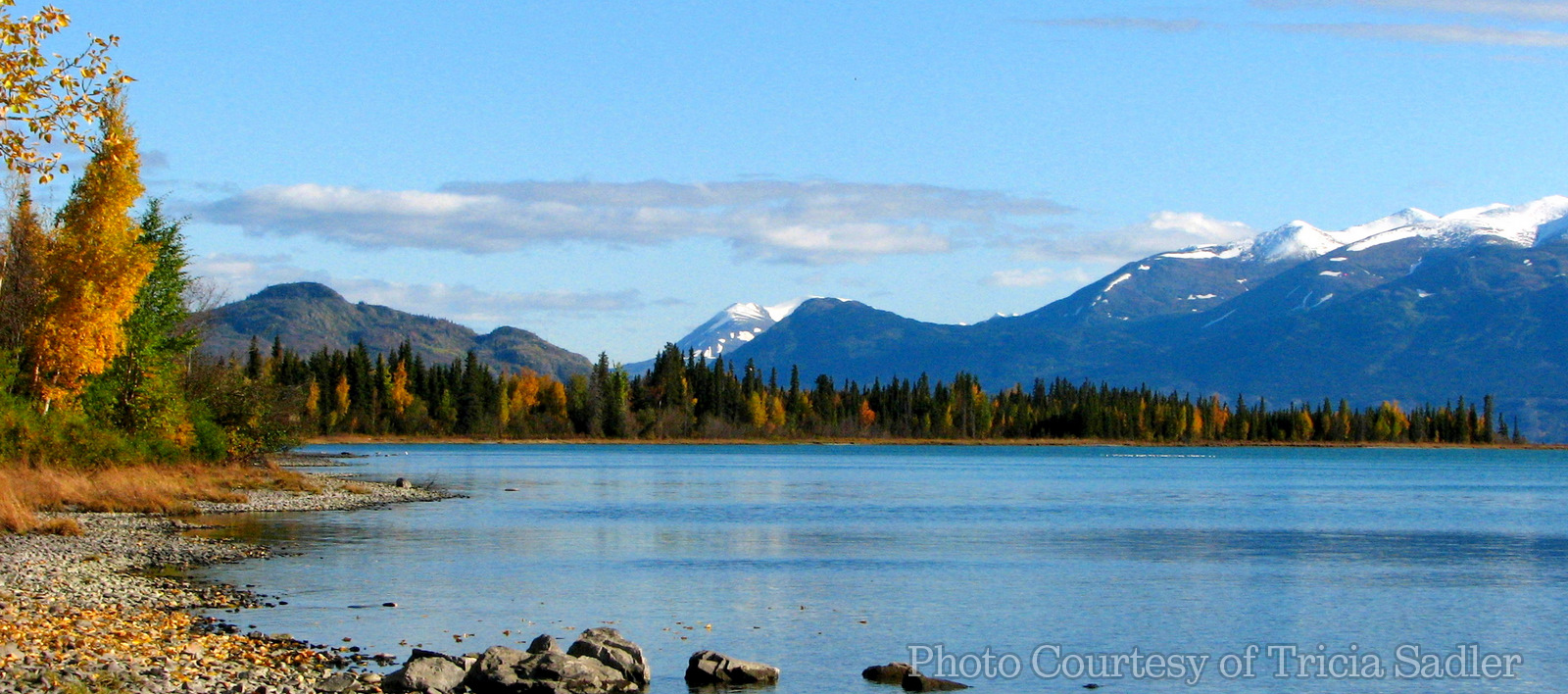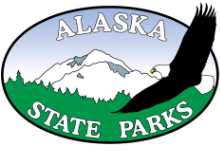Kenai River Special Management Area
General Overview
Welcome to the Kenai River Special Management Area! The Kenai River is an angler's paradise, boasting all five species of Pacific Salmon and large rainbow trout. It is Alaska's largest sport fishery, world renowned for it's record-size Chinook salmon. All in all, 36 different species of fish call the Kenai River home. Fish and anglers aren't the only ones who benefit from the remarkable Kenai; bald eagles, caribou, trumpeter swans, moose and bears are just a few of the inhabitants that make the Kenai River a prime location for watchable wildlife.
The Kenai River Special Management Area (KRSMA) was established in 1984 in response to the increasing public use and strain on the river system's health. The KRSMA contains more than 105 miles of rivers and lakes and is adjacent to 16 publically managed parks that offer prime opportunities for boating, camping, wildlife viewing and, of course, fishing. Come visit the Kenai and make your own adventure!
Kenai River Special Management Area
Headquarters and Ranger Station
35850 Lou Morgan Road
P.O. Box 1247
Soldotna, AK 99669
907-262-5581
Maps and Brochures
Kenai River Special Management Brochure
Motor Regulations Fact Sheet for Kenai River Special Management Area
For a copy of the Kenai River Special Management brochure, contact the DNR Public Information center at dnr.pic@alaska.gov.
Map of the Kenai River Special Management Area
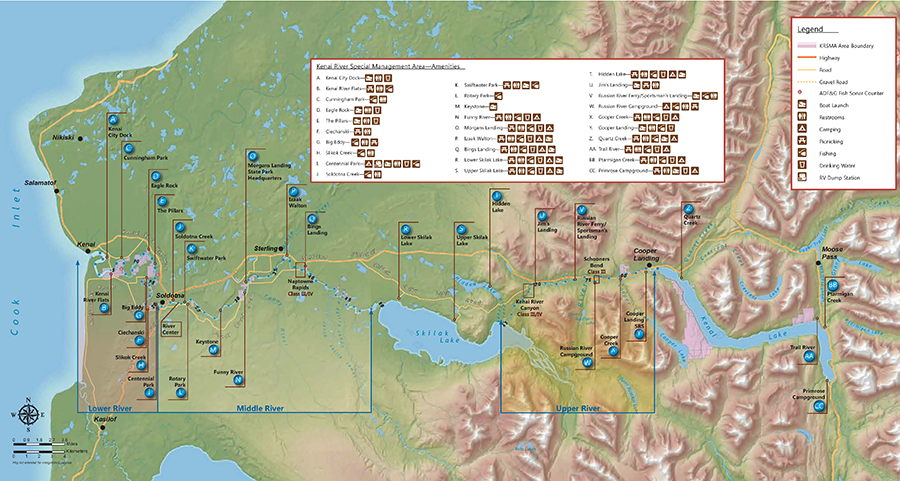
Top Five Attractions
Float the Upper Kenai River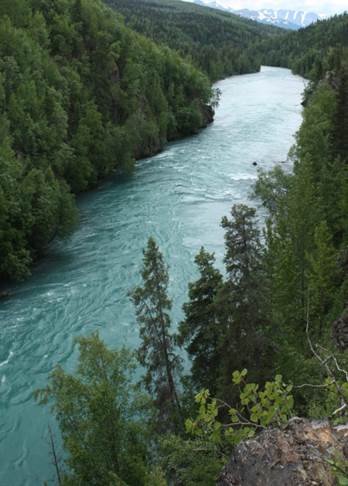
The Upper Kenai River is a drift-only section of the Kenai River Special Management Area. This section of river provides great fishing and camping opportunities and some of the most scenic vistas within the Kenai River System. Part of the Kenai's appeal comes from the Striking turquois glacial water. Boaters opting to float during the summer months are often rewarded with wildlife sightings of bear, moose and majestic bald eagles. Down stream of Jim's Landing, the Kenai River Canyon offers a wilderness feel, with a series of class II and III rapids. Enjoy this relaxing and gorgeous float through some of the most remote stretches of the Kenai River.
Sport Fishing the Mighty Kenai
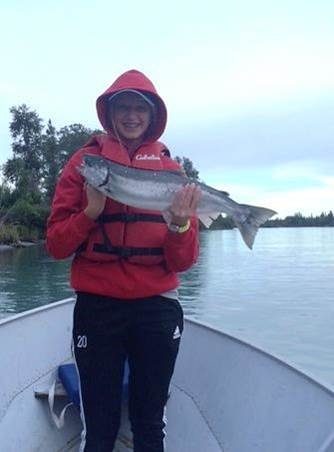 Salmon, rainbow trout and dolly Varden are the most popular species to fish for on the Kenai River. Voracious rainbow trout gorge themselves on salmon roe, tens of thousands of sockeye salmon flood the river during the peak of the run and some of the largest remaining king salmon return to spawn providing ample opportunity for fishermen and women to catch dinner. Whether you opt to hike the Upper Kenai River to cast a fly for rainbow trout or sport fish by boat with a guide, you will have a great chance to catch a fish from the bountiful waters of the Kenai River.
Salmon, rainbow trout and dolly Varden are the most popular species to fish for on the Kenai River. Voracious rainbow trout gorge themselves on salmon roe, tens of thousands of sockeye salmon flood the river during the peak of the run and some of the largest remaining king salmon return to spawn providing ample opportunity for fishermen and women to catch dinner. Whether you opt to hike the Upper Kenai River to cast a fly for rainbow trout or sport fish by boat with a guide, you will have a great chance to catch a fish from the bountiful waters of the Kenai River.
Hike a Scenic Trail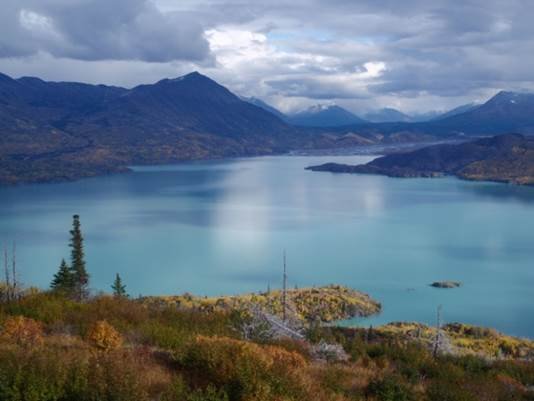 There are an abundance of trails providing access to fishing and scenic overlooks, photographic opportunities and unmatched panoramic views of the Kenai River, Skilak and Kenai Lakes. Several hiking trails near Skilak Lake deliver exceptional views of the Upper Kenai River, Skilak Lake and the Kenai Mountains. Be prepared and bring a snack, first aid kit and layers for the weather. Good hiking shoes and a set of trekking poles can make a hike even better as Alaska weather is unpredictable and can change quickly.
There are an abundance of trails providing access to fishing and scenic overlooks, photographic opportunities and unmatched panoramic views of the Kenai River, Skilak and Kenai Lakes. Several hiking trails near Skilak Lake deliver exceptional views of the Upper Kenai River, Skilak Lake and the Kenai Mountains. Be prepared and bring a snack, first aid kit and layers for the weather. Good hiking shoes and a set of trekking poles can make a hike even better as Alaska weather is unpredictable and can change quickly.
Bird Watching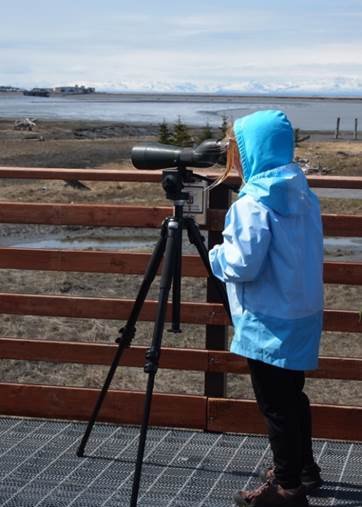 The Kenai River watershed is a birdwatchers haven. The protected river corridors, expansive lakes and tidal estuary provide excellent habitat for a variety of species. The Kenai River Flats, at the mouth of the river, is a customary resting locale for a multitude of avian species. 187 species of birds have been seen on ‘The Flats', of which a remarkable 81 species are known to breed there, at least yearly or occasionally. Tremendous congregations of waterfowl can be seen at The Flats during the spring and fall migrations. Some common Species include: Bald Eagles, Seagulls, Swans, Geese, Snipe, Plover, Arctic Tern, Sandhill Crane and many species of waterfowl. Bring a spotting scope or a pair of binoculars and enjoy the view.
The Kenai River watershed is a birdwatchers haven. The protected river corridors, expansive lakes and tidal estuary provide excellent habitat for a variety of species. The Kenai River Flats, at the mouth of the river, is a customary resting locale for a multitude of avian species. 187 species of birds have been seen on ‘The Flats', of which a remarkable 81 species are known to breed there, at least yearly or occasionally. Tremendous congregations of waterfowl can be seen at The Flats during the spring and fall migrations. Some common Species include: Bald Eagles, Seagulls, Swans, Geese, Snipe, Plover, Arctic Tern, Sandhill Crane and many species of waterfowl. Bring a spotting scope or a pair of binoculars and enjoy the view.
See a Brown Bear!
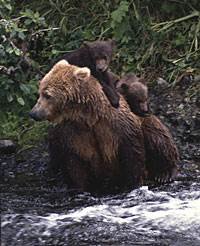 The Kenai Peninsula has a healthy population of bears. For the best opportunity to see a bear, viewers must understand bears' habits and habitat. Bears generally congregate near salmon streams in the early morning and late evening hours. This is your best chance to catch a glimpse of a great Brown bear. Look for slow moving pools in the river where salmon are likely to rest. Find a good viewpoint a safe distance away. Bears also frequent the shoreline of Kenai and Skilak Lakes scavenging for food. Patience pays off when looking to spot a bear. Be aware of your surroundings and be cautious when on or near the river.
The Kenai Peninsula has a healthy population of bears. For the best opportunity to see a bear, viewers must understand bears' habits and habitat. Bears generally congregate near salmon streams in the early morning and late evening hours. This is your best chance to catch a glimpse of a great Brown bear. Look for slow moving pools in the river where salmon are likely to rest. Find a good viewpoint a safe distance away. Bears also frequent the shoreline of Kenai and Skilak Lakes scavenging for food. Patience pays off when looking to spot a bear. Be aware of your surroundings and be cautious when on or near the river.
Recreational Opportunities
Fishing
Opportunities abound for sport fishing on the Kenai River. Each year there are two runs of Chinook (King) salmon, Sockeye (Red) salmon and Coho (Silver) salmon plus a run of Pink salmon every other year. The world record King salmon, which weighed 97 pounds 4 ounces was caught from the Kenai River in 1985. The Kenai is also home to trophy Rainbow Trout and Dolly Varden, some reaching over 30 inches in length. Sockeye salmon, or Reds as they are affectionately known due to their brilliant red spawning colors, run in late-June through early August. Reds are considered the premier salmon for eating, smoking and canning. There are numerous parks and other public access areas for fishermen looking to wet their line in the Kenai. Visit the Maps and Brochures section for information on public access areas.
Boating
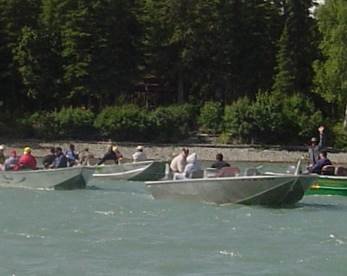 The 100+ mile Kenai River waterway is a perfect place to recreate on the water. Visitors and residents alike frequent the Kenai by raft, drift boat, kayak and power boat and pack raft. The Upper Kenai is non-motorized and provides boaters with a scenic float through a very interesting river corridor. Rocks, gravel bars, rapids, log jams, other boaters and fishermen make for an exciting float. Kenai and Skilak Lakes offer miles and miles of water to explore. These large water bodies are great for sightseeing by kayak or power boat. The Middle and Lower Kenai River are both very popular places to paddle and fish by boat. Go with the flow; don't disrupt the use pattern of other boaters. Be courteous of other boaters in these areas, give non-motorized boat traffic the right of way and slow down when traveling in congested areas and around sharp corners. Get out and enjoy the beautiful blue water of the Kenai River.
The 100+ mile Kenai River waterway is a perfect place to recreate on the water. Visitors and residents alike frequent the Kenai by raft, drift boat, kayak and power boat and pack raft. The Upper Kenai is non-motorized and provides boaters with a scenic float through a very interesting river corridor. Rocks, gravel bars, rapids, log jams, other boaters and fishermen make for an exciting float. Kenai and Skilak Lakes offer miles and miles of water to explore. These large water bodies are great for sightseeing by kayak or power boat. The Middle and Lower Kenai River are both very popular places to paddle and fish by boat. Go with the flow; don't disrupt the use pattern of other boaters. Be courteous of other boaters in these areas, give non-motorized boat traffic the right of way and slow down when traveling in congested areas and around sharp corners. Get out and enjoy the beautiful blue water of the Kenai River.
Hiking
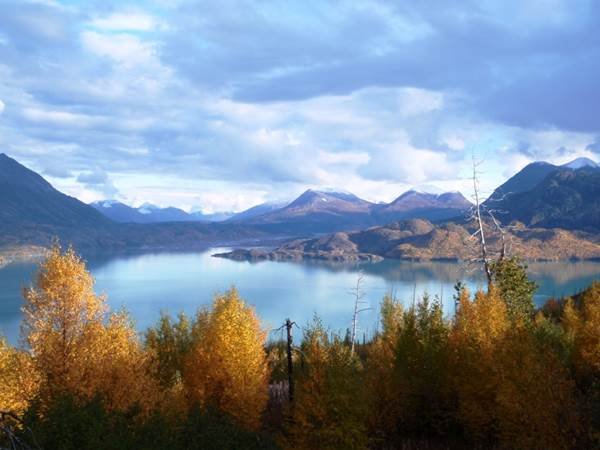
The Kenai Peninsula offers an abundance of trails providing access to fishing and scenic overlooks, photographic opportunities and unmatched panoramic views of the Kenai River, Skilak and Kenai Lakes. Some of the larger park units and recreation sites including Slikok Creek, Morgan's Landing and Bing's Landing have river access trails providing short hikes and great views of the river. Several hiking trails near Skilak Lake deliver exceptional views of the Upper Kenai River, Skilak Lake and the Kenai Mountains. Bring good hiking shoes, snacks and water and be prepared for unpredictable weather.
Camping
Camping by tent or RV is a very popular activity on the Kenai River. The KRSMA has several campgrounds to choose from, all of which are adjacent to the Kenai River. Bing's Landing Campground, Morgan's Landing Campground, Izaak Walton Campground and Funny River Campground are all located on the Middle River and provide fishing access to the River. Sites at the campground have fire rings and picnic tables and a place to park a vehicle, although the KRSMA does have several walk in sites. Camping is only permitted in developed campgrounds. All other undeveloped state lands, river islands, and day-use facilities within KRSMA are closed to camping.
Photography
The Kenai River Special Management Area abounds with photographic opportunities. The river provides a great backdrop for photographs and the majestic Kenai Mountains are often visible. Whether you are in search of the perfect sunset, stunning landscape or a shameless selfie, the KRSMA has it all. Great images are born often from hiking nearby trails, exploring the grounds near your campsite and even just driving the Sterling Highway. The Upper Kenai River parallels the Sterling Highway in several areas between Cooper Landing and Skilak Lake providing especially easy access to great views of the river. The turquoise blue water of the Kenai provides an excellent color contrast with the brilliant colors of summer and fall. The long days of summer provide up to 20 hours of light, ample opportunity to find the right lighting, although early sunrise and late sunsets may disturb your sleep cycle. Striking crimson sockeye salmon can be seen swimming in slow pools waiting to spawn. The opportunity to capture a memorable image on the Kenai is great.
Wildlife Viewing
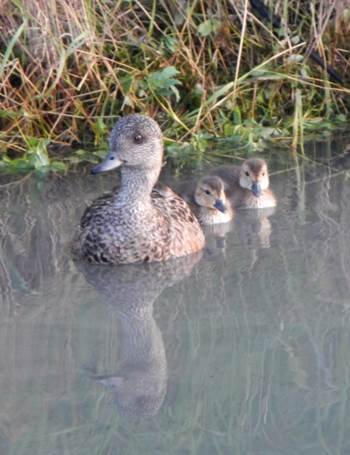 The Kenai Peninsula has distinctive and varying habitats and is considered a miniature Alaska in many regards. The Kenai Peninsula stretches some 200 miles long and 100 miles wide and features every Alaska wildlife habitat type except Arctic tundra. It also boasts extensive waterways, wetlands, roads and hiking trails that offer ample opportunity to observe wildlife. Moose and bears can be found foraging the shores of the Kenai River at many creek confluences. From the boardwalk at the Cooper Landing boat launch, visitors can often view Dall sheep on the mountains to the north and goats on the steeper slopes to the south. A multitude of bird species can also be seen flying the river corridor and fishing its waters. Salmon often swim near shore in shallow waters while migrating upstream and salmon smolt can be seen in the near shore waters feeding and journeying out to sea. Lynx, river otters, coyotes, wolves and mink also venture out during the salmon spawn, as do both brown and black bears, often when the river is quiet of boats. Trumpeter swans and eagles can be seen in quiet stretches of river and on Kenai and Skilak Lakes during the migration periods of early winter and spring. These are a few of the wildlife highlights, and most observant visitors can see many additional species of wildlife.
The Kenai Peninsula has distinctive and varying habitats and is considered a miniature Alaska in many regards. The Kenai Peninsula stretches some 200 miles long and 100 miles wide and features every Alaska wildlife habitat type except Arctic tundra. It also boasts extensive waterways, wetlands, roads and hiking trails that offer ample opportunity to observe wildlife. Moose and bears can be found foraging the shores of the Kenai River at many creek confluences. From the boardwalk at the Cooper Landing boat launch, visitors can often view Dall sheep on the mountains to the north and goats on the steeper slopes to the south. A multitude of bird species can also be seen flying the river corridor and fishing its waters. Salmon often swim near shore in shallow waters while migrating upstream and salmon smolt can be seen in the near shore waters feeding and journeying out to sea. Lynx, river otters, coyotes, wolves and mink also venture out during the salmon spawn, as do both brown and black bears, often when the river is quiet of boats. Trumpeter swans and eagles can be seen in quiet stretches of river and on Kenai and Skilak Lakes during the migration periods of early winter and spring. These are a few of the wildlife highlights, and most observant visitors can see many additional species of wildlife.
Natural History
The Kenai River has attracted people for thousands of years. The earliest archeological sites were occupied between 8,000 and 10,000 years ago, not long after glaciers receded from the area. Intensive salmon fishing began at least 2,000 years ago by the Riverine Kachemak and later by the Kenaitze Dena'ina. Both cultures were not only attracted by salmon, but also offshore fish, moose, and caribou. The river continues to provide food for local people, other Alaskans, and the world.
Russian fur traders arrived in 1741 and established a Russian settlement and fur and fish trading post in 1791. Explorer Captain James Cook sailed his namesake Cook Inlet in 1778.
Territorial Management
Since the late 1880s, commercial fishing has been an important part of the culture and economy of the Alaska. Even before statehood, canneries and buying stations had a significant impact on the Kenai Peninsula. Commercial fishing thrived in Cook Inlet for decades and it became an essential fishery during the great depression and during World War II. The salmon industry flourished atthis time and provided needed protein for Americans in the 1930s and 1940s during the food rationing by the U.S. Government. Overharvest caused salmon runs declined significantly in the 1940s and 1950s. The federal government relinquished fisheries management control when Alaska became a state in 1959, and the Alaska Department of Fish & Game was founded.
State Management
The newly formed Alaska state government tasked the Alaska Department of Fish and Game with restoring the salmon runs in Cook Inlet. Biologists began collecting data about salmon to assess the size and strength of each run. Allowing an abundance of salmon to spawn in the rivers in Cook Inlet worked to gradually increase the salmon runs. New management techniques determining salmon abundance and harvest rates allowed biologists to effectively identify when to allow commercial fishing. It took nearly three decades to restore the salmon runs and in 1980, a record return of salmon returned to Alaskan waters. The large salmon returns in the 1980s symbolized the success of Alaskan commercial fisheries management.
Sport Fishing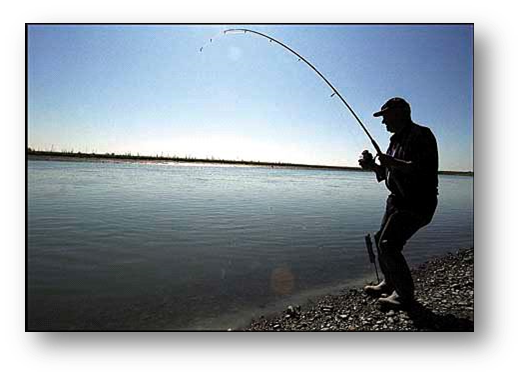
Meanwhile, the Kenai Peninsula's population began to grow and so did the popularity of sport fishing. In the 1970s and 80s inventive fishers tried a multitude of new techniques to catch king salmon and the sport fishery erupted when the world record 97 pound, 4 ounce king salmon was caught on the Kenai River in 1985. Ever since, king salmon fishing has been a tremendously popular sport on the Kenai. Today the Kenai River is the most popular fishing river in the state, boasting often healthy returns of sockeye salmon.
Kenai River Special Management Area
In 1984 the Alaska legislature recognized the importance of the Kenai River to all Alaskans and established the Kenai River Special Management Area (KRSMA). KRSMA is managed by Alaska State Parks and consists of more than 105 linear miles of river and lakes, including Kenai Lake, Skilak Lake, and the Kenai River from river mile
82 downstream to four miles above the river's mouth at Cook Inlet. Adjacent to these waters are sixteen Alaska State Park sub-units, land owned by cities, the borough, the federal government, and private lands.
The Kenai River continues to be important to the economy of the Kenai Peninsula and remains an extremely popular sport fishery. Thousands of fishermen and women flock to the shores of the Kenai to catch their limit of salmon or catch and release a trophy rainbow trout. The draw of the Kenai is often the fishing, but the area also provides a scenic landscape highlighting the turquois blue water and stunning Kenai Mountains.
Get to know the River
Fishing
The river supports two runs of sockeye, two of Chinook, two of coho salmon, and is home to thirty-three other different species of fish. As such, the Kenai River is the likely the most popular sport fishery river in Alaska. There are 4000 to 6000 people fishing daily along the banks of the Kenai River during the peak of the sockeye salmon run. The Kenai River is an irreplaceable asset to Alaskans and local wildlife, but a popular fishery cannot be maintained without careful management.
Riverbank Riparian Management
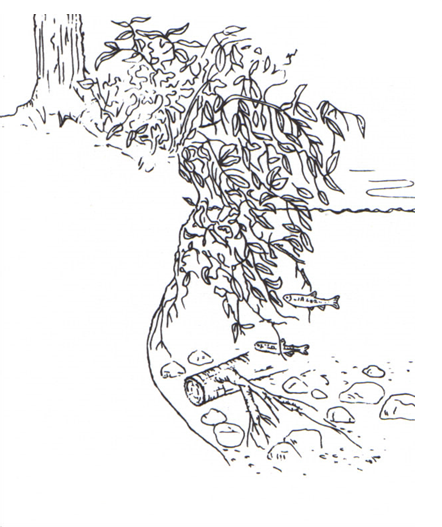 The popularity of the Kenai River puts a strain on its resources. Clean water, abundant food resources, low water velocity, vegetated banks and other habitat conditions are important to the survival of this fishery. Eighty percent of the Kenai River's juvenile salmon live within six feet of the riverbank. The riverbank's overhanging vegetation slows water velocities, provides cover, and traps food for the juvenile salmon. Numerous minor disturbances by thousands of anglers can have a devastating cumulative effect on the fragile ecosystem. Heavy foot traffic and boat wakes can destroy miles of salmon rearing habitat. Loss of riverbank vegetation means less rearing habitat is available for juvenile
salmon and the overall productivity of the Kenai River is diminished.
The popularity of the Kenai River puts a strain on its resources. Clean water, abundant food resources, low water velocity, vegetated banks and other habitat conditions are important to the survival of this fishery. Eighty percent of the Kenai River's juvenile salmon live within six feet of the riverbank. The riverbank's overhanging vegetation slows water velocities, provides cover, and traps food for the juvenile salmon. Numerous minor disturbances by thousands of anglers can have a devastating cumulative effect on the fragile ecosystem. Heavy foot traffic and boat wakes can destroy miles of salmon rearing habitat. Loss of riverbank vegetation means less rearing habitat is available for juvenile
salmon and the overall productivity of the Kenai River is diminished.
It is hard to find streams that are developed, like the lower Kenai River, that continue to produce salmon. When the riverbank is unhealthy, young fish cannot thrive. Without healthy vegetation along the banks of the Kenai, the number of salmon will dwindle. Please help protect the stream bank vegetation by using existing trails, boardwalks and fishing platforms when accessing the river.
Kenai River Sections
Upper River - Kenai Lake to Skilak Lake
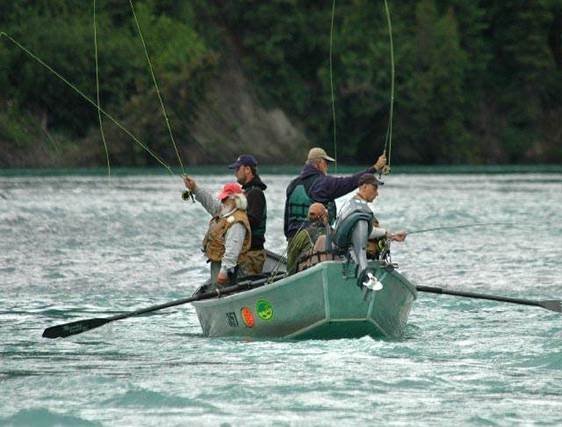 Kenai Lake is a large, glacially fed lake at the headwaters of the Kenai River. Kenai Lake flows into the Upper Kenai River in the community of Cooper Landing. The Upper Kenai River, or 'Upper Kenai' as it is commonly known, from Kenai Lake to Skilak Lake is a drift-only section of the Kenai River Special Management Area. The entire Kenai River is popular for fishing, but an incredible amount of people fish near the confluence of the Russian River and Kenai River for the first run of sockeye salmon. This is one of the most congested areas on the river system. During fishing season it is important to be vigilant in this area. The Russian River Ferry also transports people across the river near the confluence of the Russian River at mile 73.5. The Sterling Highway parallels a stretch of the Upper River, allowing easy access for bank fishermen. Popular bank fishing areas occur at several locations along this segment. Boaters should be prepared if floating the Kenai River Canyon below Jim's Landing as several Class II and III rapids exist.
Kenai Lake is a large, glacially fed lake at the headwaters of the Kenai River. Kenai Lake flows into the Upper Kenai River in the community of Cooper Landing. The Upper Kenai River, or 'Upper Kenai' as it is commonly known, from Kenai Lake to Skilak Lake is a drift-only section of the Kenai River Special Management Area. The entire Kenai River is popular for fishing, but an incredible amount of people fish near the confluence of the Russian River and Kenai River for the first run of sockeye salmon. This is one of the most congested areas on the river system. During fishing season it is important to be vigilant in this area. The Russian River Ferry also transports people across the river near the confluence of the Russian River at mile 73.5. The Sterling Highway parallels a stretch of the Upper River, allowing easy access for bank fishermen. Popular bank fishing areas occur at several locations along this segment. Boaters should be prepared if floating the Kenai River Canyon below Jim's Landing as several Class II and III rapids exist.
Hazards
High winds can whip Kenai and Skilak Lakes into frothy whitecaps in minutes. Please be aware that the water temperature is quite cold, possibly below 40 degrees almost year round. Use caution when boating on the lakes, remember to check the weather, leave a float plan, and always wear a life jacket. Consider staying on shore when it is windy.
Middle River - Skilak Lake to Soldotna Bridge
The outlet of Skilak Lake to the Upper Killey River is highly stable because of the presence of large gravel dunes created by a pre-1950's flood surge. This section of the Kenai River contains important habitats for spawning and rearing salmon. This section of the river is more developed than the Upper River and can be very busy, especially during the months of June through October when salmon and trout runs are high. Several species are targeted by recreational anglers in this area, including king, coho, and sockeye salmon, rainbow trout, and Dolly Varden.
Hazards
Naptowne Rapids is rated class III/IV whitewater and is located directly downstream from Bings Landing. Boaters need to use extreme caution when launching from this site. Power boaters should make sure that the boat motor is operating properly and allow it time to warm up. Everyone should wear a life jacket. There are numerous rocks and gravel bars between Skilak Lake and the Soldotna Bridge. Many rocks are partially submerged and may be difficult to see.
Lower River – Soldotna Bridge to Cook Inlet
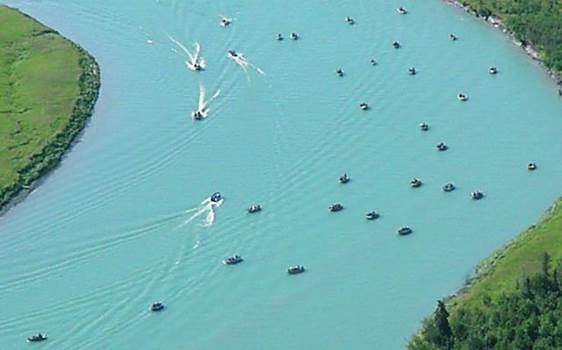 The lower Kenai River is often congested with boat traffic. Please follow the rules of the road when operating on this section of the river and give way to all non-motorized boats. It is important to note that the lower reach of the Kenai River is tidally influenced upstream to approximately river mile 13, near Honeymoon Cove. Be aware of gravel bars, mud flats, and rocks, which in some cases, are only visible at low tide. Please be courteous to other boaters while operating on the Lower Kenai River.
The lower Kenai River is often congested with boat traffic. Please follow the rules of the road when operating on this section of the river and give way to all non-motorized boats. It is important to note that the lower reach of the Kenai River is tidally influenced upstream to approximately river mile 13, near Honeymoon Cove. Be aware of gravel bars, mud flats, and rocks, which in some cases, are only visible at low tide. Please be courteous to other boaters while operating on the Lower Kenai River.
Hazards
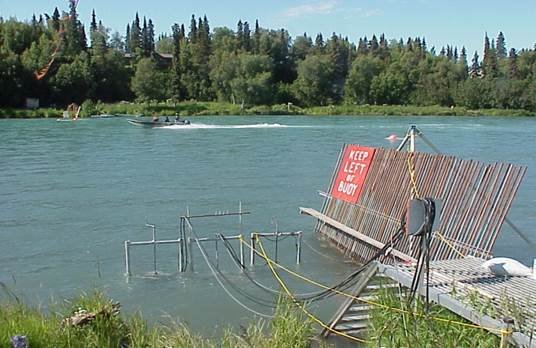 Along with the usual hazards of rocks and gravel bars, this stretch of river generally has a significant amount of boat traffic during June, July, August and even September. Please be aware and courteous to other boaters. The Alaska Department of Fish and Game operates fish wheels, sonar sites and in river test fishing below the Soldotna Bridge during the summer months. Please stay mid-channel and avoid all fish and game equipment while operating on the Kenai River. Beware also of commercial fishing vessels moored near Cook Inlet.
Along with the usual hazards of rocks and gravel bars, this stretch of river generally has a significant amount of boat traffic during June, July, August and even September. Please be aware and courteous to other boaters. The Alaska Department of Fish and Game operates fish wheels, sonar sites and in river test fishing below the Soldotna Bridge during the summer months. Please stay mid-channel and avoid all fish and game equipment while operating on the Kenai River. Beware also of commercial fishing vessels moored near Cook Inlet.
Fishing the Kenai
The Kenai River is the most popular sport fishing destination in Alaska, particularly for salmon and trout. The Kenai offers an abundance of options for anglers; bank fishing, back trolling, drifting, back bouncing, catch-and-release, personal use dipnetting, subsistence fishing, and guided fishing are just some of the opportunities available in the fishery. There is no such thing as a personal fishing hole. Different methods are popular in different river reaches – Please don't buck the trend. Opting to drift through back trolling areas or back bouncing where others are drift fishing is often unsafe. This frequently causes tangled lines, hot tempers, and even boat collisions or accidents. Courtesy and common sense will make everyone's experience more enjoyable.
Bank Fishing
Fishing from shore is an extremely popular method on the Kenai. Many public facilities in Kenai, Soldotna, Sterling and Cooper Landing have trails, boardwalks and fishing platforms for river access. Please see the Maps and Brochures section for a list of public access areas. Please respect the rights of the many private land-owners along the Kenai River. Angling the Kenai can be enjoyable and orderly if everyone works together to have fun, catch fish and enjoy this remarkable river.
- Do not trespass, dock, bank fish, picnic, or camp without permission
- Use developed trails when possible
- Avoid walking on sensitive riparian areas including shoreline vegetation, tree roots, and sloughing gravel
Courtesy on the River
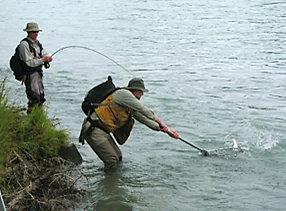
Patience is a virtue! Please be kind and courteous to others at fishing holes, while boating the river, when launching boats and parking at facilities. Fishing should be fun. A smile and a helping hand can calm many stressful situations.
Landing a salmon on the Kenai is challenging enough without worrying about the crowds. The universal signal for "Fish On" is an upraised landing net. Help out other anglers by pulling in your line, stepping out of the way, offering to net their fish and/or steering your boat well away from the fish. If your fishing line becomes entangled with someone else's line that has a salmon on, cut your line immediately. The line with the fish on has the "right-of-way."
Sport Fishing Regulations
Anglers should obtain a current copy of the Sport Fishing Regulations and keep it accessible while fishing. Snagging or attempting to snag any fish is illegal in all fresh waters of Alaska. To snag a fish means to hook the fish anywhere other than in its mouth. Anglers must purchase a valid sport fishing license if age 16 or older. Licenses, tags and permits are available at all Alaska Department of Fish and Game offices, many sporting good and grocery stores. Licenses and tags can also be purchased online at www.admin.adfg.state.ak.us/license. If you have questions about fishing regulations, please contact the Alaska Department of Fish and Game (ADF&G) office in Soldotna at 907-262-9368.
Kenai River Guides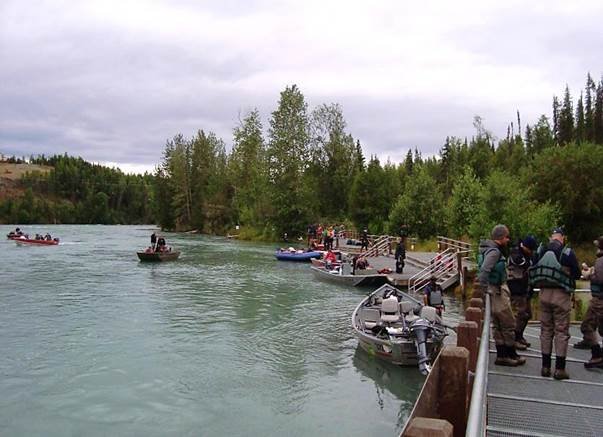
Guides must have a state park commercial use permit and meet safety, training and insurance requirements. Be sure your guided vessel displays current Kenai River guide decal, a large three digit boat number and the Kenai River SMA guide identification.
Kenai River Guides are not allowed to verbally or physically harass, assault, or abuse clients, employees, outfitters, other guides and their clients, or members of the general public. For additional information regarding guiding, to report a guide's unprofessional behavior or to report violations please contact Alaska State Parks at (907) 262-5581. A list of permitted Kenai River guides is available at the Gilman River Center at (907) 260-4882.
Catch and Release Fishing
Catch and release fishing is highly rewarding if done correctly. Fish must be released immediately and if done correctly will suffer very little permanent injury and will spawn successfully. Here are some suggestions on releasing that will reduce harm to fish.
- Land fish quickly. Playing a fish to exhaustion takes energy away needed for spawning.
- Do not remove fish from the water, even to take photographs.
- Keep your hands away from the gills. Putting your hands under the gill plate could injure the fragile gill arches and could cause death.
- Handle fish gently. Grasp fish around the body when removing the hook. A pair of long-nosed pliers or a hemostat works best for backing the hook out.
- If the fish is hooked deeply, cut the line as close as possible to the hook. Do this only if removing the hook will cause more damage than leaving it in. Use steel hooks that will quickly rust out; avoid using stainless steel hooks.
- Gently support the fish in the water with its head pointed upstream until it swims away on its own.
Boating Safety on the Kenai River
The Kenai River's 105 miles of lakes and rivers offer ample opportunity to recreate on the water. Knowledge, skill and vigilance are required to operate a boat safely - especially in crowded boating conditions and near hazards. Please learn the US Coast Guard "rules of the road" for your safety and others. Everyone should wear personal flotation devices (PFDs) when boating the Kenai. Children under the age of 13 are required by law to have a life jacket on at all times in an open boat or on an open deck. A list of the Alaska boating legal requirements summary can be found online at
https://dnr.alaska.gov/parks/boating/pdf/boatrequire120309.pdf
Power Boating
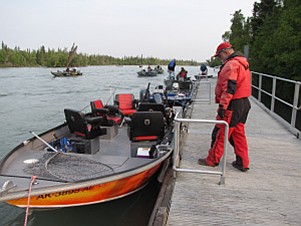 Power boating on Alaska's Kenai River is both an exhilarating recreational activity and important means of access. River boating allows access to special places that might otherwise be out of reach. However, the power of moving river water is relentless. Non-motorized boats and boats drifting downstream have the right-of-way. Boats under power headed or pointed upstream must yield to other traffic.
Power boating on Alaska's Kenai River is both an exhilarating recreational activity and important means of access. River boating allows access to special places that might otherwise be out of reach. However, the power of moving river water is relentless. Non-motorized boats and boats drifting downstream have the right-of-way. Boats under power headed or pointed upstream must yield to other traffic.
Boat operators are legally responsible for their boats' wake and any damage it causes. Please travel mid-river whenever possible. Use appropriate speeds and keep wake to a minimum to reduce bank erosion and silting of spawning beds. Approach other boats and property, such as docks, carefully.
Alaska State Parks would like to remind boaters that 2008 regulations phasing out the use of older, two-stroke outboard motors in the Kenai River Special Management Area (KRSMA) have been fully implemented. Two-stroke motors that do not employ direct fuel injection technology can no longer operate at any time of year in the special management area, which extends from one mile downstream of the Warren Ames Bridge to the Cooper Landing area and includes both Skilak and Kenai Lakes. For more information, please contact the Kenai/Prince William Sound Area state park office at 907-262-5581.
Paddlers
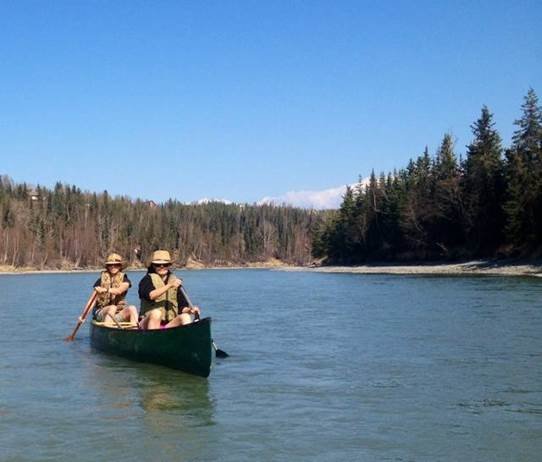 River paddlers should be strong swimmers and be in good physical condition. Choose boats designed for rough river currents. Highly stable kayaks, canoes, and rafts with a very low center of gravity and covered decks are ideal. In addition to legal requirements and the other items recommended for all boaters, paddlers should also carry: paddle float, paddle leash, stirrup, towing strap, plenty of visual distress signals (including a signal mirror) and maybe even a spare paddle.
River paddlers should be strong swimmers and be in good physical condition. Choose boats designed for rough river currents. Highly stable kayaks, canoes, and rafts with a very low center of gravity and covered decks are ideal. In addition to legal requirements and the other items recommended for all boaters, paddlers should also carry: paddle float, paddle leash, stirrup, towing strap, plenty of visual distress signals (including a signal mirror) and maybe even a spare paddle.
Hazards
The Kenai is a big, fast, and cold river. You must be prepared for crowded boating conditions, natural and man-made hazards, and cold water. No one ever expects boating emergencies, but they happen—so always be prepared. Most boating fatalities in Alaska involve cold water immersion resulting from a person falling overboard or a boat capsizing. Dress appropriately and help those in need. Kenai and Skilak Lakes are very cold and subject to sudden high winds which kick up choppy waves. Stay on shore in bad weather. The Alaska Office of Boating Safety offers presentations describing the effects of cold water immersion and actions you can take to increase your chances of survival. For more information or to request a presentation for your agency or organization, contact Joe McCullough at (907) 269-8704 or joseph.mccullough@alaska.gov.
Many natural hazards exist on the Kenai River including: rapids, rocks, sweepers, log jams, sand and gravel bars, submerged objects, animals, wind, sunlight, fog, and of course, other boaters. Boaters should be skilled in turning with and against current, launching, landing and beaching, anchoring, basic troubleshooting and repairs, and reading the water. Exercising good judgment and applying the right mix of skill, ability, and caution are never more important than when power boating on rivers.
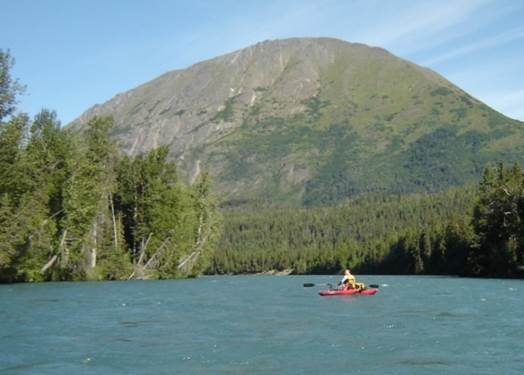 The Alaska Department of Fish and Game also operates sonar sites on the Kenai River for counting fish. When boating, please obey the warning signs near the sonar sites and stay mid-river when traveling by boat. Submerged equipment and buoy lines can easily entangle fishing gear, hooked fish, and engine drive units. Besides a damaged propeller or lost fish and tackle, disturbance to sonar equipment may result in costly repairs and loss of critical data. Anglers should immediately cut their lines if they become entangled with sonar equipment. Boaters may also see ADF&G research vessels or equipment such as weirs or traps anywhere along the river. Please maintain sufficient distance from these research projects to avoid entanglement and damage. Boaters may also be approached by researchers during "creel surveys" to take measurements and scale samples and gather statistics from retained salmon. The Department thanks boaters in advance for their participation and cooperation in helping manage this fishery.
The Alaska Department of Fish and Game also operates sonar sites on the Kenai River for counting fish. When boating, please obey the warning signs near the sonar sites and stay mid-river when traveling by boat. Submerged equipment and buoy lines can easily entangle fishing gear, hooked fish, and engine drive units. Besides a damaged propeller or lost fish and tackle, disturbance to sonar equipment may result in costly repairs and loss of critical data. Anglers should immediately cut their lines if they become entangled with sonar equipment. Boaters may also see ADF&G research vessels or equipment such as weirs or traps anywhere along the river. Please maintain sufficient distance from these research projects to avoid entanglement and damage. Boaters may also be approached by researchers during "creel surveys" to take measurements and scale samples and gather statistics from retained salmon. The Department thanks boaters in advance for their participation and cooperation in helping manage this fishery.
For additional information about boating on the Kenai River, view the Boaters Safety handbook to the Kenai River.
Please see the boat and motor restrictions on the Kenai River for more information.
Frequently Asked Questions
Do you take reservations? Campsites are reserved on a first come, first served basis.
Where is a good place to camp? Bing's Landing Campground, Izaak Walton Campground, Morgan's Landing Campground, and Funny River Campground are popular camping locations operated by Alaska State Parks. See the Maps and Brochures section for more information.
How much does it cost per night? Camping fees are listed on our fee page.
Can I have a fire? Fires are allowed in portable camp stoves and metal fire rings provided by the park. 11 AAC 12.180
Where can I get firewood? Wood that is both dead and lying on the ground may be gathered for use within the park. No wood may be gathered for use outside the park. Check with local campground hosts; bundles of firewood are available in some campgrounds for a small fee. When in doubt, bring your own. 11 AAC 12.170
Can I bring my pet? Pets must be on leash at all campgrounds, picnic areas, parking lots and trailheads, and under complete control (e.g. voice) in the backcountry. Please clean up after your pet. 11 AAC 12.130
Where is a good place to fish on the Kenai River? There are numerous public facilities that provide fishing access. State Park facilities include: Bing's Landing, Izaak Walton Campground, Morgan's Landing, Funny River Campground, and Slikok Creek State Rec. Site. Other public access points include: Moose Ranger Meadows, Swiftwater Park, Gilman River Center, Soldotna Creek Park, Centennial Park and Cunningham Park. These are some of the most popular bank fishing areas on the Kenai River.
What guide service should I fish with? The State of Alaska Division of Parks has a current list of all commercially registered guides operating on the Kenai River. Please contact Alaska State Parks at (907) 714-2471 for additional information.
Can I light off fireworks in the park? The discharge of fireworks is not allowed in state parks. They can injure visitors, disturb wildlife and cause wildfires. 11 AAC 12.197
Can I land my airplane or helicopter in the park? The use of fixed wing aircraft is allowed in the park with the following restrictions: Aircraft landings are prohibited on state park land within the KRSMA. Practice landings are allowed only on Kenai and Skilak Lakes. The waters of the Kenai River between the Warren Ames Bridge at river mile 5 and the Soldotna Bridge at river mile 21 are closed to the use of aircraft during the months of June and July. Helicopter landings are not allowed in the park. 11 AAC 20.855
Are there fees at the park? There is a $15.00 camping fee, $5.00 day use fee and boat launch fees for use of these State Park facilities along the Kenai River. Fees help maintain our park facilitates. If you are a frequent user you may consider purchasing an annual pass.
When do I need a permit? Permits are required for the organized assembly of more than 20 people, any entertainment, athletic, or competitive event, any incompatible use, research involving disturbance or collection of park resources, and for commercial activities. See the Permits section for more information. 11 AAC 18.010
Can I pick berries in the park? Yes, berries and edible plants may be gathered for personal consumption, but not for sale. Collecting, damaging or disturbing rocks, trees, other plants or minerals is prohibited. 11 AAC 12.170
Motor Regulations Fact Sheet for Kenai River Special Management Area
Permits
The River Center in Soldotna is a multi-agency permitting, information and education center. Borough, state, and federal agencies work together to protect the natural resources associated with Kenai Peninsula watersheds. Alaska State Parks at the Gilman River Center issues permits for the building of structures (i.e., roads, buildings, bank restoration, floating docks, walkways etc.), in the Kenai River Special Management Area and the Alaska State Park units on the Kenai Peninsula. The permitting staff also issues non-competitive park use permits for commercial activities in Alaska State Park units.
http://www.kenairivercenter.org
Commercial Park Use Permits
Persons conducting commercial activities within the Kenai River Special Management Area must obtain, in advance, a permit issued by the Division of Parks and Outdoor Recreation. Water taxis, flight seeing tours, fishing guides, white water rafting, kayak tours, back country hiking, and boat rentals are just a few of the businesses that operate in Alaska State Parks on the Kenai Peninsula.
Commercial Operators are not authorized to operate in the park until the permit has been issued. Commercial Use Permit applications and required documentation may be submitted online.
Special Park Use Permits
Special Use Permits are required for a wide variety of special events, such as those listed below. A special use permit is not required for regular recreation activities.
For a complete list of commercial and non-commercial activity fees, please read the current Director's Order on State Park Fees.
- Groups of 20 or more people.
Example: Company picnic or family reunion.
- Other organized events.
Example: Weddings.
Included with the Special Use Permit will be a list of standard, general stipulations. Permits may also include additional stipulations customized to your specific situation.
Regulations
The following list of regulations help govern the management of the Kenai River. For the complete list of State Park and additional Kenai River specific regulations contact Alaska State Parks at (907) 262-5581 or visit the Alaska Statutes and Regulations web page at
http://www.legis.state.ak.us/basis/folio.asp
- Aircraft - Aircraft landings are prohibited on Alaska State Park land within the Kenai River Special Management Area. Practice landings are allowed only on Kenai and Skilak Lakes. The waters of the Kenai River, between the Warren Ames Bridge at river mile 5 and the Soldotna Bridge at river mile 21, are closed to the use of aircraft during the months of June and July. 11 AAC 20.855
- Anchoring - A person may not anchor a boat on the Kenai River in a manner that obstructs a primary traffic channel or drift fishing channel in any section of the river. Anchor Buoys are allowed although they must be attended except while pursuing a hooked fish as long as the person returns to the anchored buoy within 20 minutes. 11 AAC 20.862
- Boat Specifications - A person may not operate a motorized boat in the Kenai River Special Management Area that exceeds 21 feet in overall length and 106 inches in overall width. 11 AAC 20.861
- Camping is allowed only in developed campsites. All undeveloped lands and islands are closed to camping. There are many areas, including the islands below Skilak Lake, which are closed to camping and bank fishing during sockeye season. 11 AAC 20.880
- Drift Areas, Motor Use Prohibited - Operating a boat by use of a motor is prohibited year-round on the Kenai River from Skilak Lake upstream to river mile 80.7 near Cooper Landing. From March 15 to June 14, operating a boat by use of a motor on the Kenai River is also prohibited from river mile 47 upstream to the outlet of Skilak Lake. A person may not launch or operate an airboat, hovercraft, hydroplane, or a personal watercraft except as described under Personal Watercraft regulations. 11 AAC 20.865
- Fires must be in a portable camp stove or confined to a structure provided by the Division for fires. 11 AAC 12.180
- Fireworks may not be discharged in a state park. 11 AAC 12.197
- Horsepower Restrictions - No one may operate a boat in the Kenai River Special Management Area with an outboard, or combination of outboards, having a total propshaft rating greater than 50 HP. Adding a jet drive to any boat does not change its equivalent propshaft HP rating. These HP restrictions do not apply to Kenai and Skilak lakes, or the river between RM 80.7 and Kenai Lake. 11 AAC 20.860
- Horsepower Markings - No one may operate a boat on the Kenai River unless the original or altered horsepower of the motor is clearly labeled by the manufactures cowling decal appropriate to the rated propshaft horsepower. 11 AAC 20.860
- Litter - Carry out everything you bring into the park, including food scraps, packaging, cigarette butts and fishing line. 11 AAC 12.050
- No Wake Areas - A person may not operate a boat or aircraft at a speed greater than five miles per hour in the following no wake areas: between the Kenai Lake Bridge and river mile 80.7 in Cooper Landing, within the Moose River between the Sterling Highway Bridge and the confluence with the Kenai River, the north channel of the Kenai River from river mile 11 downstream through lower Beaver Creek to its confluence with the main channel of the Kenai River at approximately river mile 10. 11 AAC 20.870
- Passenger Limits - No more than six persons are allowed on board a powerboat on the river, including the operator. During the month of July, guided vessels may not have more than five persons on board, including the operator. 11 AAC 20.862
- Personal Watercraft -A person may operate a personal watercraft only on Kenai Lake on the portion of the lake that is north of a line running from the Primrose Campground boat launch to a prominent marker on the east shore of Kenai Lake, and east of a line running from the Chugach Electric Association powerhouse to a marker on the south side of Porcupine Island, and north to the Forest Service campground on the north side of Porcupine Island between the hours of 10:00a.m. and 10:00 p.m. A person may not operate a personal watercraft within 300 feet of shore at speeds greater than five miles per hour or in a manner that creates a wake. 11 AAC 20.867
- Pets must be on a leash in developed campgrounds and day-use areas and under control at all times. 11 AAC 12.130
- Snowmobiles are only allowed on Kenai Lake from December 1 through April 30 annually when the snow depth is adequate to protect the underlying vegetation on upland approaches and on Skilak Lake in accordance with 50 C.F.R. 36.39(i)(4). 11 AAC 20.857
- Tying Up - No one may tie up a boat to state land, easements, or right-of-ways for more than 24 consecutive hours. 11 AAC 20.862
- Use of Weapons - The use and discharge of a weapon for the purpose of lawful hunting or trapping is allowed in the KRSMA only on Skilak Lake and Kenai Lake, except that a person may use and discharge a shotgun below Skilak Lake for the purpose of lawful hunting or trapping from September 1 to April 30 annually, the discharge of any firearm is prohibited within one-half mile of a developed facility or dwelling. A person may discharge a shotgun using steel shot no larger than size T, 0.2 inches in diameter, at a distance of no less than one-quarter mile from a developed facility or dwelling. 11 AAC 20.850
- Water Skiing - Except for Kenai Lake, no person may water ski on waters of the Kenai River Special Management Area. 11 AAC 20.875
- 4-stroke or Direct Fuel Injected 2-stroke motors required - 4-stroke or direct fuel injected 2-stroke motors are required. 11 AAC 20.860
- Kenai River Guide Permits- A person may not provide professional guide services without first obtaining a permit issued by the division. 11 AAC 20.885
Motor Regulations Fact Sheet for Kenai River Special Management Area
KRSMA Management
The Kenai River Comprehensive Management Plan is the basis for management of state land and waters within the Kenai River Special Management Area and other state land within the planning boundaries of the Management Plan. The management plan was developed by agencies and a public advisory board, and guides the cooperative efforts of the land managers. The plan's goal is to protect the natural resources and fish and wildlife habitat, manage the river's recreational and commercial uses, and provided public facilities.
KRSMA Comprehensive Management Plan
Kenai River Special Management Area Advisory Board
The Kenai River Special Management Area Advisory Board was originally created in 1985 under the authority of A.S. 41.21.510. The original Board was charged with developing a comprehensive management plan for the Kenai River. The original Comprehensive Plan was completed and the Board disbanded in 1986. In 1988 a new Board was appointed to help advise the Department of Natural Resources on implementation of the Plan. In 1997 the Board worked to update the Kenai River Comprehensive Management Plan, and it was adopted in December 1997. In May 2004 the Alaska Legislature passed a bill that changed the composition of the board from what the law had directed in the original 1984 KRSMA statute.
The Kenai River Special Management Area Advisory Board meets the second Thursday of each month from September to May. The meetings are held at the Donald R. Gilman River Center, 514 Funny River Road, Soldotna and begin at 5:30 p.m. For copies of the latest agenda and minutes please contact the Kenai/Prince William Sound Area Office at 907-714-2470.
KRSMA Board Meeting Minutes
KRSMA Committees
Committee Meetings
Resolutions
Action Items:
Committee Purposes & Objectives
Criterion for Public Members of Board Committees
Nomination Policy and Procedures
50 Foot Ordinance
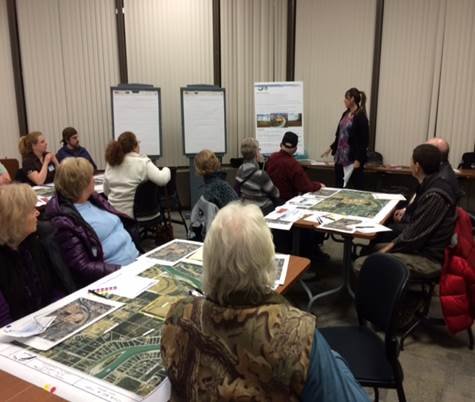
Kenai River Recreation Study - Major Findings and Implications - October 2010
U.S. Army Corps of Engineers Boat Waves on Johnson Lake and Kenai River 2001 (PDF)
2009 Kenai River Recreation Use Study
Kenai River Guide Academy
1982-2011 Commercial Operator Trends
Contact Information
| Kenai/Prince William Sound Area Office 35850 Lou Morgan Road PO BOX 1247 Soldotna, AK 99669 907-262-5581 |
Gilman River Center 514 Funny River Road Soldotna, AK 99669 907-714-2482 |

